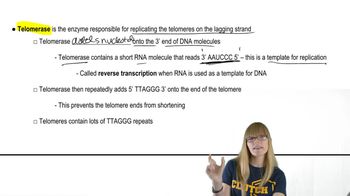Table of contents
- 1. Introduction to Genetics51m
- 2. Mendel's Laws of Inheritance3h 37m
- 3. Extensions to Mendelian Inheritance2h 41m
- 4. Genetic Mapping and Linkage2h 28m
- 5. Genetics of Bacteria and Viruses1h 21m
- 6. Chromosomal Variation1h 48m
- 7. DNA and Chromosome Structure56m
- 8. DNA Replication1h 10m
- 9. Mitosis and Meiosis1h 34m
- 10. Transcription1h 0m
- 11. Translation58m
- 12. Gene Regulation in Prokaryotes1h 19m
- 13. Gene Regulation in Eukaryotes44m
- 14. Genetic Control of Development44m
- 15. Genomes and Genomics1h 50m
- 16. Transposable Elements47m
- 17. Mutation, Repair, and Recombination1h 6m
- 18. Molecular Genetic Tools19m
- 19. Cancer Genetics29m
- 20. Quantitative Genetics1h 26m
- 21. Population Genetics50m
- 22. Evolutionary Genetics29m
8. DNA Replication
Telomeres and Telomerase
Problem 11b
Textbook Question
There is a problem completing the replication of linear chromosomes at their ends. Describe the problem and identify why telomeres shorten in each replication cycle.
 Verified step by step guidance
Verified step by step guidance1
<insert step 1> The problem with replicating linear chromosomes is that DNA polymerase can only add nucleotides to the 3' end of a pre-existing chain, requiring a primer to initiate synthesis.>
<insert step 2> During replication, the leading strand is synthesized continuously, but the lagging strand is synthesized in short fragments called Okazaki fragments, each requiring a new primer.>
<insert step 3> At the very end of the lagging strand, once the final RNA primer is removed, there is no upstream 3' end available for DNA polymerase to fill in the gap, leading to a short, unreplicated segment.>
<insert step 4> This unreplicated segment results in the progressive shortening of the chromosome ends, known as telomeres, with each cell division.>
<insert step 5> Telomeres are repetitive nucleotide sequences that protect the ends of chromosomes, but as they shorten with each replication cycle, they eventually reach a critical length that can trigger cellular senescence or apoptosis.>
Recommended similar problem, with video answer:
 Verified Solution
Verified SolutionThis video solution was recommended by our tutors as helpful for the problem above
Video duration:
2mPlay a video:
Was this helpful?
Key Concepts
Here are the essential concepts you must grasp in order to answer the question correctly.
Telomeres
Telomeres are repetitive nucleotide sequences located at the ends of linear chromosomes. They protect the chromosome from deterioration or fusion with neighboring chromosomes. Each time a cell divides, a portion of the telomere is not replicated, leading to gradual shortening over successive replication cycles.
Recommended video:
Guided course

Telomeres and Telomerase
DNA Replication
DNA replication is the process by which a cell duplicates its DNA before cell division. It involves unwinding the double helix and synthesizing new strands complementary to the original ones. However, due to the nature of DNA polymerase, which cannot fully replicate the ends of linear chromosomes, telomeres become progressively shorter with each replication.
Recommended video:
Guided course

Steps to DNA Replication
Hayflick Limit
The Hayflick limit refers to the number of times a normal somatic human cell can divide before cell division stops, which is typically around 40-60 divisions. This limit is largely due to telomere shortening, as critically short telomeres trigger cellular senescence or apoptosis, preventing further replication and contributing to aging and tissue regeneration limitations.
Recommended video:
Guided course

Sex-Linked Genes

 8:38m
8:38mWatch next
Master Telomeres and Telomerase with a bite sized video explanation from Kylia Goodner
Start learningRelated Videos
Related Practice

